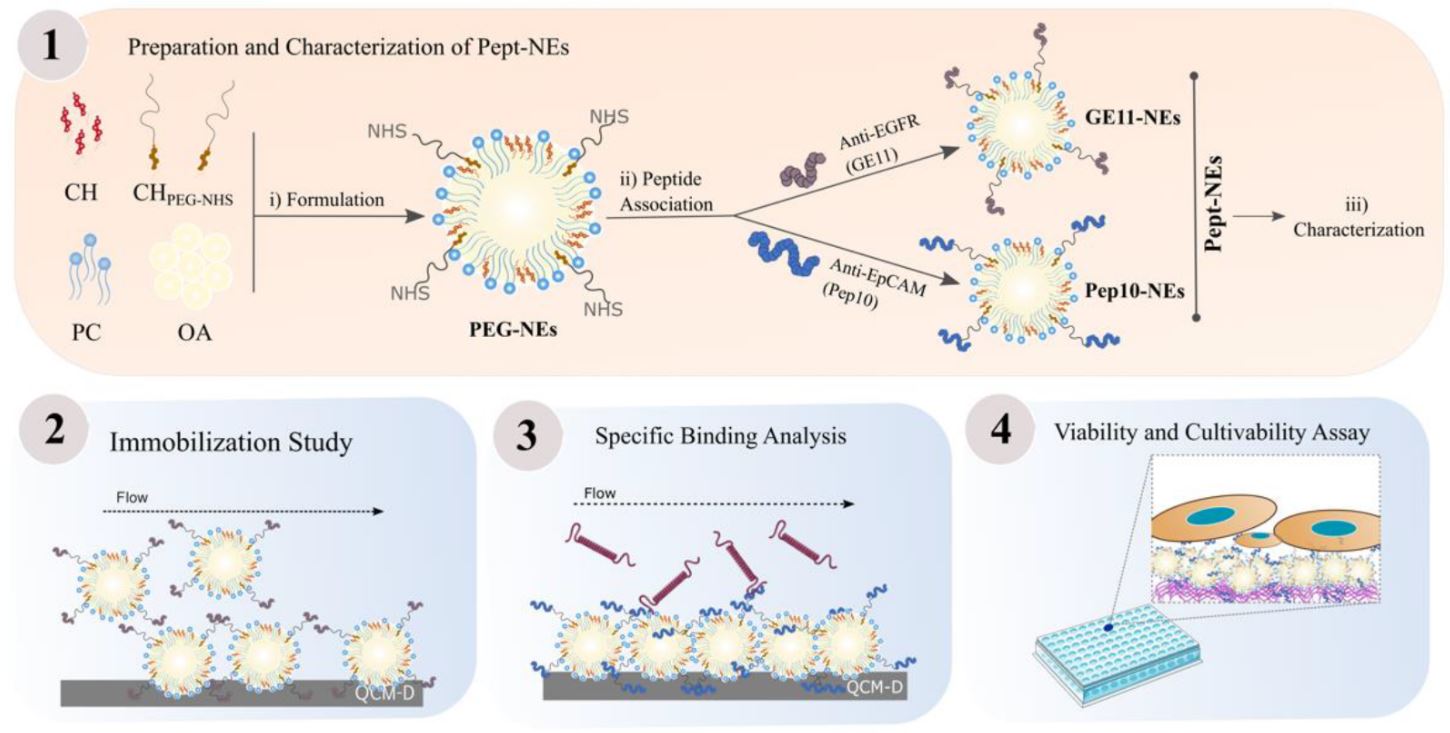Peptide-Functionalized Nanoemulsions as a Promising Tool for Isolation and Ex Vivo Culture of Circulating Tumor Cells

Circulating Tumor Cells (CTCs) are shed from primary tumors and travel through the blood, generating metastases. CTCs represents a useful tool to understand the biology of metastasis in cancer disease. However, there is a lack of standardized protocols to isolate and culture them. In our previous work, we presented oil-in-water nanoemulsions (NEs) composed of lipids and fatty acids, which showed a benefit in supporting CTC cultures from metastatic breast cancer patients. Here, we present Peptide-Functionalized Nanoemulsions (Pept-NEs), with the aim of using them as a tool for CTC isolation and culture in situ. Therefore, NEs from our previous work were surface-decorated with the peptides Pep10 and GE11, which act as ligands towards the specific cell membrane proteins EpCAM and EGFR, respectively.
We selected the best surface to deposit a layer of these Pept-NEs through a Quartz Crystal Microbalance with Dissipation Monitoring (QCM-D) method. Next, we validated the specific recognition of Pept-NEs for their protein targets EpCAM and EGFR by QCM-D and fluorescence microscopy. Finally, a layer of Pept-NEs was deposited in a culture well-plate, and cells were cultured on for 9 days in order to confirm the feasibility of the Pept-NEs as a cell growth support. This work presents peptide-functionalized nanoemulsions as a basis for the development of devices for the isolation and culture of CTCs in situ due to their ability to specifically interact with membrane proteins expressed in CTCs, and because cells are capable of growing on top of them.
Download the research paper as PDF: Peptide-Functionalized Nanoemulsions as a Promising Tool for Isolation and Ex Vivo Culture of Circulating Tumor Cells
Reagents and Solvents
Lipoid® S100 PC (18:0/18:1) from soybean (94%) was a gift from Lipoid GmbH (Ludwigshafen, Germany). Cholesterol Polyethylene glycol N-Hydroxysuccinimide (CH PEG NHS; MW: 2 kDa) was purchased from Nanocs Inc. (New York, NY, USA). OA, CH, TopFluor® PC, Dimethyl Sulfoxide (DMSO), Polylysine (PLL, MW 30–70 kDa), Cell Counting Kit-8 (CKK-8), trypsin with EDTA solution, acetic acid solution, FBS, BSA, and penicillin-streptomycin were purchased from Merck KGaA (Sigma-Aldrich®, Darmstadt, Germany). Ethanol (absolute) was purchased from Scharlab, S.L (Barcelona, Spain). Amicon® Ultra-4 100 K centrifugal filters were provided by Merk (Millipore® Darmstadt, Germany). MQ-water was purified by Millipore® Direct-Q® 3 with a UV system. dPBS and High-glucose DMEM were purchased from Biowest (Nuaillé, France). Tissue culture dishes (100 mm) were provided by VWR International, LLC (Avantor®, Barcelona, Spain). Black 96-well plates and ultra-low-attachment 24-well plates were purchased from Corning Inc. (Corning, NY, USA). Paraformaldehyde solution (PFA) 4% in PBS and NucBlueTM Hoechst 33,342 dye were purchased from Thermo Fisher Scientific, (Waltham, MA, USA). Human EGFR protein (His Tag-Biotinylated; 630 aa, MW: 69.8 kDa) and Human EpCAM protein (His Tag-Biotinylated; 253 aa, MW: 29 kDa) were provided by Sino Biological Inc. (Eschborn, Germany). All peptides were purchased from GenScript, (TWIN HELIX SRL, Rome, Italy): GE11 (12aa: YHWYGYTPQNVI), fluorescent GE11 (13aa; sequence: YHWYGYTPQNVI {K (TMR)}), Pep10 (23aa; sequence: VRRDAPRFSMQGLDACGGNNCNN), and fluorescent Pep10 (24aa; sequence VRRDAPRFSMQGLDACGGNNCNN {K (TMR)}).
Carmona-Ule, N.; Gal, N.; Abuín Redondo, C.; De La Fuente Freire, M.; López López, R.; Dávila-Ibáñez, A.B. Peptide-Functionalized Nanoemulsions as a Promising Tool for Isolation and Ex Vivo Culture of Circulating Tumor Cells. Bioengineering 2022, 9, 380. https://doi.org/10.3390/bioengineering9080380

